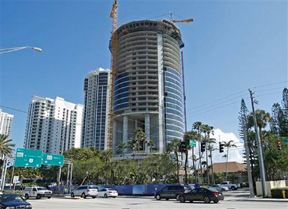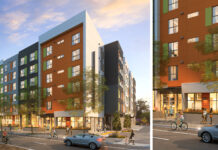
SUNNY ISLES BEACH, Florida: The wow factor for Miami’s skyscraper condos no longer comes from a dazzling Atlantic Ocean view.
It takes something more audacious to sell beachfront property these days to the global ultra-wealthy who arrive in Miami with millions to spend on second or third homes. It takes words invested with meaning in the language of the international jet set:
Porsche. Giorgio Armani. Fendi.
With a slew of residential and hotel developments, Miami is embracing the notion that homes, like cars, handbags and jewelry, should carry luxe designer labels. The trend has spread from Europe, Asia and the Middle East, where developers discovered a few years ago that luxury-branded hotels and homes could command huge premiums that the moneyed set would happily pay.
Having transformed New York and London, the wealthy are increasingly pursuing new havens. Miami is luring Argentinians, Brazilians, Chinese, Russians and French, some of whom seek refuge from political instability and higher taxes at home. The purchases go beyond the appeal of haute logos: Owning an asset priced in dollars can protect fortunes from the shrunken values of euros, pesos and rubles.
The pull is so powerful that developer Gil Dezer’s Porsche Design Tower is mostly sold-out, even though construction won’t wrap until early 2016, meaning that most buyers committed millions based on blueprints.

Shaped like a piston driven into sand, the concrete-and-glass Porsche Design Tower will contain three car elevators. Each can whisk a convertible up 60 stories and then slide it into the owner’s personal steel-reinforced garage. (The owner can stay in the driver’s seat.) Inside the apartments, curved windows capture a vista of waves billowing from a midnight blue into a pale green along the shore.
For the designers and builders, the partnership offers dual rewards: The brands gain a revenue stream and enhance their caché. The developers and owners benefit from the allure of a treasured name and logo.
“
What we’re selling is luxury,” Dezer said. “The buyers already know the brand. They like the style, they like the look and that’s why they feel more comfortable buying it.”
Dezer is also taking reservations for condos at the Armani Casa. The Chateau Group is building the Fendi Chateau (named for the Italian fashion house) steps from the Chanel, Gucci and Tiffany boutiques.
Nearby is the Faena District, a condo, hotel and cultural center backed by Argentinian hotelier and fashion designer Alan Faena.
Their emergence has spawned thousands of skilled construction jobs. Yet it’s also produced an epic surge in home prices. And it’s walled off Miami’s coastline behind a phalanx of skyscrapers that has isolated low and middle-income residents. Many have had to buy farther and farther inland, said Aaron Drucker, a managing agent for Redfin, the real estate brokerage.
“Locals are not really part of the party,” Drucker said. “It’s a little bittersweet for folks who aren’t going to be able to enjoy the beauty of Miami.”
Demand from European and South American buyers caused prices for the top 5 percent of homes around Miami Beach to surge 66 percent in the past year to $6.3 million, according to Redfin. That compares with a 5 percent increase in luxury prices nationwide. Miami Beach’s gains dwarfed the price increases of top-tier homes in San Francisco, Los Angeles and Washington D.C.
Global buyers are largely paying with cash. Some may be shifting their holdings from U.S. bank accounts after the IRS sought to reduce tax avoidance in 2012 by requiring banks to report interest earned on accounts held by foreigners. Those accounts are estimated to hold up to $400 billion, according to court filings.
Two-thirds of sales in the Miami area were all-cash, compared with 48 percent in other U.S. markets with high proportions of international buyers, Redfin found. Nationwide, by contrast, all-cash sales accounted for only about a quarter of purchases in February, according to the National Association of Realtors.
A result is that the demand for branded condos is far outpacing the fundamentals of a Miami-area economy that’s still recovering from the housing bust. Over the past year, average hourly wages in metro Miami have risen just 1.3 percent to $22.74 an hour, according to the Labor Department, below national averages.
“The typical metrics used to measure real estate markets – such as local job growth – don’t apply here,” said Neisen Kasdin, a former Miami Beach mayor and lawyer who represents developers of the Faena District. “I’ve never seen this congregation of wealth before.”
Branded homes are helping attract some buyers who weren’t familiar with Miami’s luxury housing, said Liam Bailey, global head of research at the London-based real estate consultancy Knight Frank.
“There is a marketing benefit of having a brand that is recognized outside the market,” Bailey said. “There is an element of trust.”
The developers enjoy a growing pool of wealth to target. Roughly 173,000 individuals worldwide are worth more than $30 million, a population that rose 3 percent last year, according to a report by Knight-Frank. Their numbers are forecast to swell an additional 34 percent over the next decade, meaning that more foreign buyers will be looking for homes in New York, Los Angeles, Miami and elsewhere.
In setting up the Porsche Design Tower, Dezer identified and sent packages to 1,500 individuals with an affinity for the German automaker. The outreach produced 62 sales. -AP






